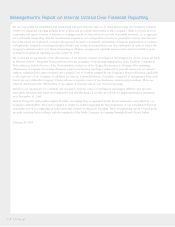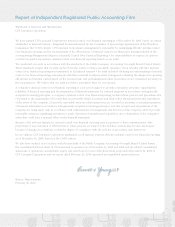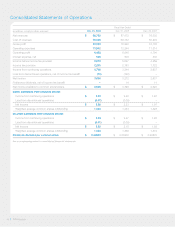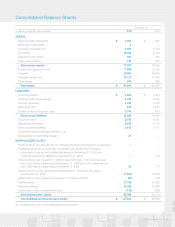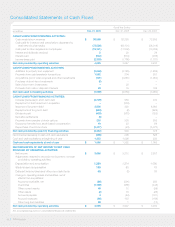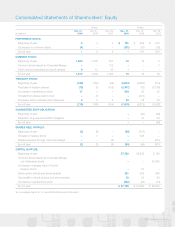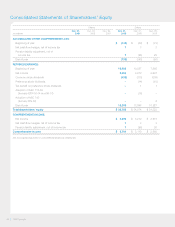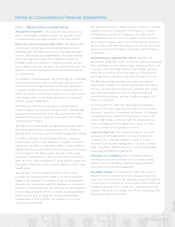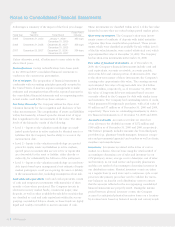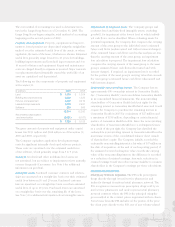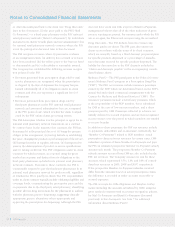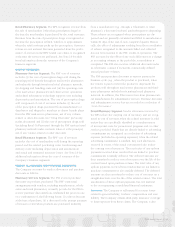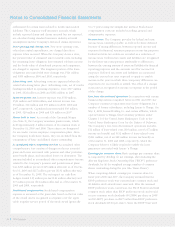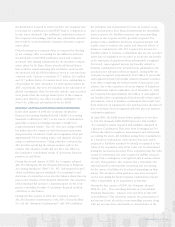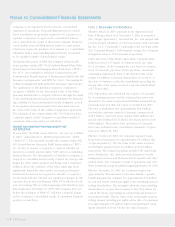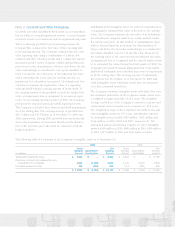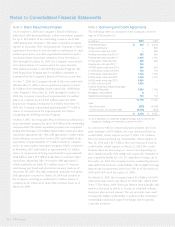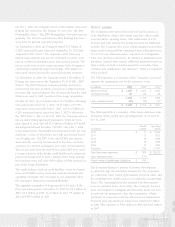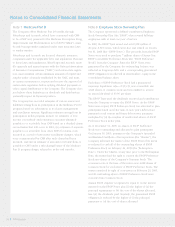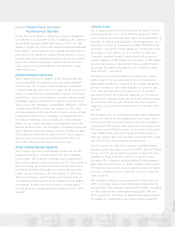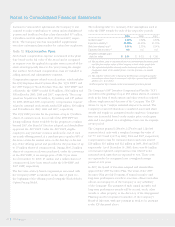CVS 2009 Annual Report Download - page 56
Download and view the complete annual report
Please find page 56 of the 2009 CVS annual report below. You can navigate through the pages in the report by either clicking on the pages listed below, or by using the keyword search tool below to find specific information within the annual report.
Notes to Consolidated Financial Statements
does not have credit risk with respect to Retail Co-Payments,
management believes that all of the other indicators of gross
revenue reporting are present. For contracts under which the PSS
acts as an agent, the PSS records revenues using the net method.
Drug Discounts – The PSS deducts from its revenues any
discounts paid to its clients. The PSS pays discounts to its
clients in accordance with the terms of its client contracts,
which are normally based on a fixed discount per prescription
for specific products dispensed or a percentage of manufac-
turer discounts received for specific products dispensed. The
liability for discounts due to the PSS’ clients is included in
“Claims and discounts payable” in the accompanying consoli-
dated balance sheets.
Medicare Part D – The PSS participates in the Federal Govern-
ment’s Medicare Part D program as a Prescription Drug Plan
(“PDP”). The PSS’ net revenues include insurance premiums
earned by the PDP, which are determined based on the PDP’s
annual bid and related contractual arrangements with the
Centers for Medicare and Medicaid Services (“CMS”). The
insurance premiums include a beneficiary premium, which
is the responsibility of the PDP member, but is subsidized
by CMS in the case of low-income members, and a direct
premium paid by CMS. Premiums collected in advance are
initially deferred in accrued expenses and are then recognized
in net revenues over the period in which members are entitled
to receive benefits.
In addition to these premiums, the PSS’ net revenues include
co-payments, deductibles and co-insurance (collectively, the
“Member Co-Payments”) related to PDP members’ actual
prescription claims in its net revenues. In certain cases, CMS
subsidizes a portion of these Member Co-Payments and pays
the PSS an estimated prospective Member Co-Payment subsidy
amount each month. The prospective Member Co-Payment
subsidy amounts received from CMS are also included in the
PSS’ net revenues. The Company assumes no risk for these
amounts, which represented 3.5%, 1.3% and 0.8% of consoli-
dated net revenues in 2009, 2008 and 2007, respectively.
If the prospective Member Co-Payment subsidies received
differ from the amounts based on actual prescription claims,
the difference is recorded in either accounts receivable or
accrued expenses.
The PSS accounts for CMS obligations and Member Co-Pay-
ments (including the amounts subsidized by CMS) using the
gross method consistent with its revenue recognition policies
for Mail Co-Payments and Retail Co-Payments (discussed
previously in this document). See Note 7 for additional
information about Medicare Part D.
or other discounts paid back to the client (see “Drug Discounts”
later in this document), (ii) the price paid to the PSS (“Mail
Co-Payments”) or a third-party pharmacy in the PSS’ national
retail pharmacy network (“Retail Co-Payments”) by individuals
included in its clients’ benefit plans and (iii) administrative fees
for national retail pharmacy network contracts where the PSS
is not the principal as discussed later in this document.
The PSS recognizes revenue when: (i) persuasive evidence
of an arrangement exists, (ii) delivery has occurred or services
have been rendered, (iii) the seller’s price to the buyer is fixed
or determinable and (iv) collectability is reasonably assured.
The Company has established the following revenue recogni-
tion policies for the PSS:
• Revenues generated from prescription drugs sold by mail
service pharmacies are recognized when the prescription
is shipped. At the time of shipment, the Company has per-
formed substantially all of its obligations under its client
contracts and does not experience a significant level of
reshipments.
• Revenues generated from prescription drugs sold by
third-party pharmacies in the PSS’ national retail pharmacy
network and associated administrative fees are recognized
at the PSS’ point-of-sale, which is when the claim is adjudi-
cated by the PSS’ online claims processing system.
The PSS determines whether it is the principal or agent for its
national retail pharmacy network transactions on a contract
by contract basis. In the majority of its contracts, the PSS has
determined it is the principal due to it: (i) being the primary
obligor in the arrangement, (ii) having latitude in establishing
the price, changing the product or performing part of the service,
(iii) having discretion in supplier selection, (iv) having involve-
ment in the determination of product or service specifications
and (v) having credit risk. The PSS’ obligations under its client
contracts for which revenues are reported using the gross
method are separate and distinct from its obligations to the
third-party pharmacies included in its national retail pharmacy
network contracts. Pursuant to these contracts, the PSS is
contractually required to pay the third-party pharmacies in its
national retail pharmacy network for products sold, regardless
of whether the PSS is paid by its clients. The PSS’ responsibilities
under its client contracts typically include validating eligibility and
coverage levels, communicating the prescription price and the
co-payments due to the third-party retail pharmacy, identifying
possible adverse drug interactions for the pharmacist to address
with the physician prior to dispensing, suggesting clinically
appropriate generic alternatives where appropriate and
approving the prescription for dispensing. Although the PSS
CVS Caremark
52


